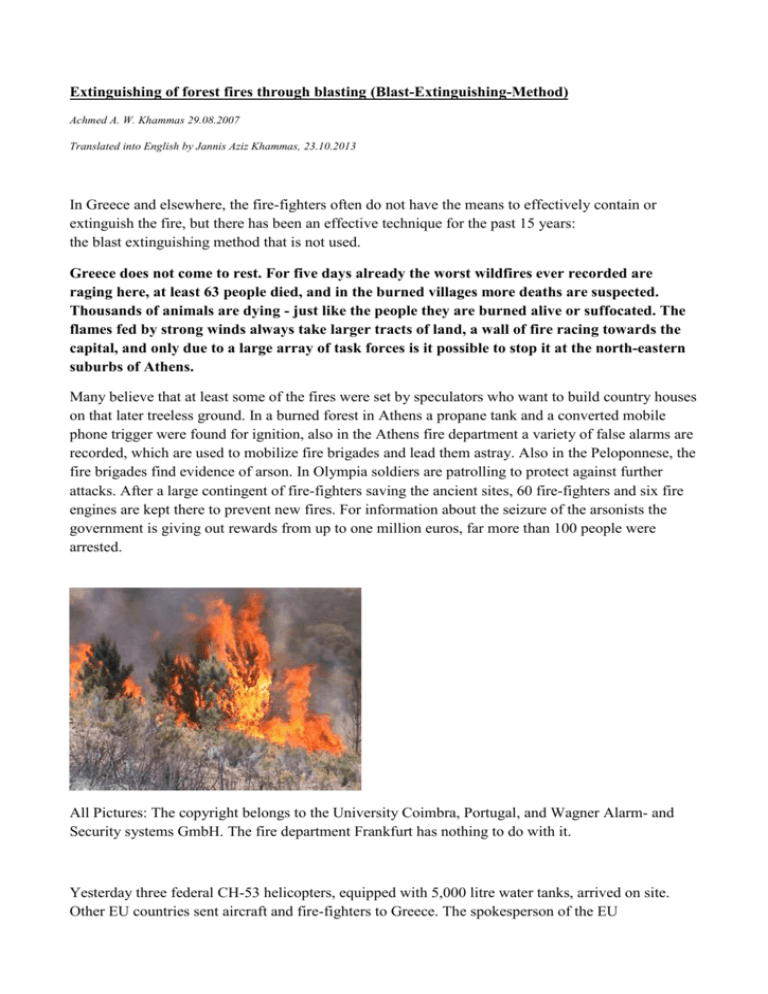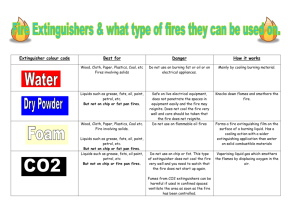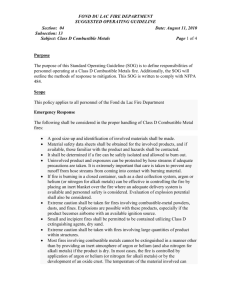Extinguishing of forest fires through blasting
advertisement

Extinguishing of forest fires through blasting (Blast-Extinguishing-Method) Achmed A. W. Khammas 29.08.2007 Translated into English by Jannis Aziz Khammas, 23.10.2013 In Greece and elsewhere, the fire-fighters often do not have the means to effectively contain or extinguish the fire, but there has been an effective technique for the past 15 years: the blast extinguishing method that is not used. Greece does not come to rest. For five days already the worst wildfires ever recorded are raging here, at least 63 people died, and in the burned villages more deaths are suspected. Thousands of animals are dying - just like the people they are burned alive or suffocated. The flames fed by strong winds always take larger tracts of land, a wall of fire racing towards the capital, and only due to a large array of task forces is it possible to stop it at the north-eastern suburbs of Athens. Many believe that at least some of the fires were set by speculators who want to build country houses on that later treeless ground. In a burned forest in Athens a propane tank and a converted mobile phone trigger were found for ignition, also in the Athens fire department a variety of false alarms are recorded, which are used to mobilize fire brigades and lead them astray. Also in the Peloponnese, the fire brigades find evidence of arson. In Olympia soldiers are patrolling to protect against further attacks. After a large contingent of fire-fighters saving the ancient sites, 60 fire-fighters and six fire engines are kept there to prevent new fires. For information about the seizure of the arsonists the government is giving out rewards from up to one million euros, far more than 100 people were arrested. All Pictures: The copyright belongs to the University Coimbra, Portugal, and Wagner Alarm- and Security systems GmbH. The fire department Frankfurt has nothing to do with it. Yesterday three federal CH-53 helicopters, equipped with 5,000 litre water tanks, arrived on site. Other EU countries sent aircraft and fire-fighters to Greece. The spokesperson of the EU Environment Commissioner Barbara Helfferich said on ZDF, the agency was "pleased with the quick assistance of the EU Member States". Within just 48 hours twelve aircraft and helicopters were deployed. But just as the existing fire fighting aircraft, which are almost in continuous use every day, they often cannot rise due to bad wind conditions. Europe, summer 2007. The media is speaking of an "apocalyptic dimension" of the disaster. And at the same time conceal an ultimately equally apocalyptic dimension of ignorance and incompetence before the devastating fires. But for this we have to go back nearly 15 years - and to Frankfurt am Main. Goal and Technology Prof. Dipl.-Ing. Reinhard Ries becomes Director of the Frankfurt fire department in 1993. Two years later, together with the explosives expert Winfried Rosenstock he presents a specially developed new method for use in extinguishing forest fires. Because the high fire intensity and sometimes extreme speed of up to 30 km / h of wildfires, even today fire-fighters are still put in front of almost insurmountable problems. Even though fire-fighting planes and helicopters offer the opportunity to fight the fire in inaccessible areas, the high extinguishing water use is a problem, due to evaporation and wind influence a significant portion of the water does not directly reach into the fire. At the same time the extremely high temperatures of such fires also provide the ground crews with major difficulties, because for the successful suppression of the fire, a necessary close distance brings the forces often in highest danger. But Ries and Rosenstock close the gaps of common extinguishing methods with a method that for the first time in the history of mankind makes high-intensity fire fronts with temperatures of 1000 ° C and more controllable from the ground. In 1996 the two men registered their system as the 2RS system. Their so-called "blast extinguishing method" allows the extinguishing agent to be used directly on the fire front. This tubing is made of plastic coated fabric equipped with a detonating cord, installed at a safe distance parallel to the fire front, and then filled with water. Shortly before the fire reaches the hose, or even when the fire front rolls over it, the hose explodes and shatters the water to "cold steam". This means the water shatters into individual molecules at a significant speed at up to 200 m / s as it is thrown onto the flames and the burning material below. On the entire length of the hose the forest fire erased in a split second and 15 meters deep, while the trees and other burning material on the other side. This produces a double effect: a sudden extinguishing of the flame front and a sustainable cooling of combustible material, which makes re-lighting as good as impossible. The blast extinguishing method provides the opportunity to attack flame fronts on a larger width and from a safe distance for the first time, which was not possible until now due to the high heat load. Buildings and establishments objects such as gas stations or fuel storage can be protected from being scrolling through flame fronts now and entire villages. By early laying and filling the tubes, the helpers are even able to create a defence in front with high extinguishing efficiency - and this even with low water use. The length of the tubes, depending on the type and intensity of the fire, can range from a few meters to several hundred meters. For example, with a 100 m long tube with a diameter of 25 cm, the same 5,000 litres of water are spread over an area of about 3,600 square meters - and such a tube can be prepared from only three men in less than seven minutes! Trial and use Using explosives to extinguish fire? When I first heard of this technique, I had some doubts, and so thought the involved decision makers. But Ries and Rosenstock are professionals and have already done enough testing - the idea is to be on the way for lifesaving product. Although it took some time for a company in Langenhagen to acquire the license rights, but already in 2000 because of the French Research Institute for Forest Fires (CEREN) a corresponding research application was submitted to the EU. Under the name FIMEX (Forest FIre fighting Method with EXplosive hoses filled with an extinguishing agent) and the participation of four medium-sized companies from Germany and France, within the Research Programme CRAFT, they developed existing prototypes to become market ready. The scientific achievements of the two research institutions selected by the companies in France and Greece (!) were even fully paid by the EU. To the funded services included field tests, creating application guidelines and the development of software with digital maps and recommendations for the use of the explosive hose depending on weather conditions and terrain. It was also investigated whether the effectiveness of the explosive hoses in fighting forest fires using other extinguishing agents could not even be significantly improved. Because the combination of water and other extinguishing agents (and often dyed red to serve the pilots of fire fighting aircraft as a marker) lie on the vegetation and not evaporate as fast as pure water. The project was launched on 1st April 2001 and Completed on the 31st March 2003. In addition to a training exercise in 2001 in Brandenburg, where the Berlin local branch Reinickendorf was involved, experimental campaigns were carried out in particular with Mediterranean vegetation (!). So took part a unit of the Frankfurt fire department in May 2002 at the International Disaster Response Exercise of the NATO "Taming the Dragon - Dalmatia 2002" in Croatia. Baseline scenarios were extensive vegetation fires in Central Dalmatia, covering several villages. The local fire departments were in continuous use, the exhausted forces needed much support. Croatia requested international assistance from the Member States of the "NATO Partnership for Peace". From today's perspective, this scenario almost borders on prophecy - you only have to replace the country's name. The effective extinguishing effect of the blasting hose technology has also been demonstrated in Portugal (Gestosa, May 2002) and at various places in the South of France (2002 and 2003). As an employee of the licensee and coordinator of the project FIMEX, Mrs. Florence Daniault, presented the research results in June 2005 at the International Conference on Risk and Emergency Management - Research and Policy Perspectives in Hanover, the results of the breakthrough appeared to be managed. But they had reckoned without the host. Obstacles and pitfalls The company WAGNER alarm and security systems in Langenhagen, which had acquired the rights of Ries and Rosenstock, can already offer three types of individual tubesat this time, which are characterized by their capacity (litres per meter), the height and the width of their flooding zone, and the distribution of water on the floor and its penetration of the combustible materials. The individual tubes are already optimized so that they distribute a maximum of extinguishing agent evenly on both sides of the blasting hose. Clever combinations are being developed. The so-called "double hose" - two adjacent hoses of the same diameter designed with the same explosive force is designed specifically for use in crown fires on mountain slopes or in strong winds. Here in the blast a pulse superimposition is achieved, the result is a vertical wall of water up to 30 m height. The "Combi-Tube" - two adjacent designed hoses with different diameters - is again designed for intense full fires, which are fed by high grown undergrowth: The big hose with low-yield acts as a water donor, the smaller hose with greater explosive power as a driving force for alignment and speed. Here, more than 80% of the extinguishing water can be brought to the front and upwards. One would actually think that Ries and Rosenstock would be showered with prizes, the blasting hose technology is international spread and devastating forest fires now a thing of the past. The Frankfurts also consider to form a task force that would operate only a few hours after its alarm throughout Europe with their helicopters. But the reality is (fatally) different. Even if you look on the website of Wagner, it is said: > No documents were found containing the term 2RS! < Instead, the guys drive off with their fire trucks, spraying into the flames until no one can stand anymore while undirected rain pours out of airplanes and helicopters like in the middle Ages. This is by no means a disparagement of their - unfortunately, all too often actually - self-sacrificing deployment. But it is legitimate to ask why is the blasting hose technology not applied? The answer to that expresses all the misery of our modern, over managed world - in which hardly anyone would take resolute and unwavering unconventional decisions anymore, even if they could save the lives and property of many, many people! Only once are difficulties in the obtaining, storage and user training mentioned. Dealing with the 2RS system requires an explosive permission of the state authorities of each country. In Greece, a use is prevented because it is forbidden there to work with electrical detonators (!). Not in every fire department has an explosives expert available. The transport of even small amounts of explosives (even in the thickest tubes is only 40 grams per meter) is running the gauntlet through a maze of different rules. Obtaining approvals is made almost impossible by the various bureaucracies involved. And this, even though the company Dynamit Nobel agreed to guarantee about its in-house distribution network to provide the tubes within 24 hours or at any desired location. So there is a lack of political will, at least not until their own house is burning down. And so this fantastically effective technology is only used for dust control while destroying big buildings. Were it not so serious, then mocking laughter would be the only adequate response. As a result of the many deaths in Greece, the European Commission is currently considering a European fire protection force to respond even faster. Thereby also the ridiculous bureaucratic barriers that incompetence, parochialism and backward thinking in the administration would have to be addressed in problem solving, and without further hesitation, ridded from the world. Because fires will ignite in future summers. In Greece and Spain, as in Portugal and other countries all around the world. For this you need not be a prophet. But you can arm yourself against it - for example with the ingenious technique of blasting hose of Ries and Rosenstock!






